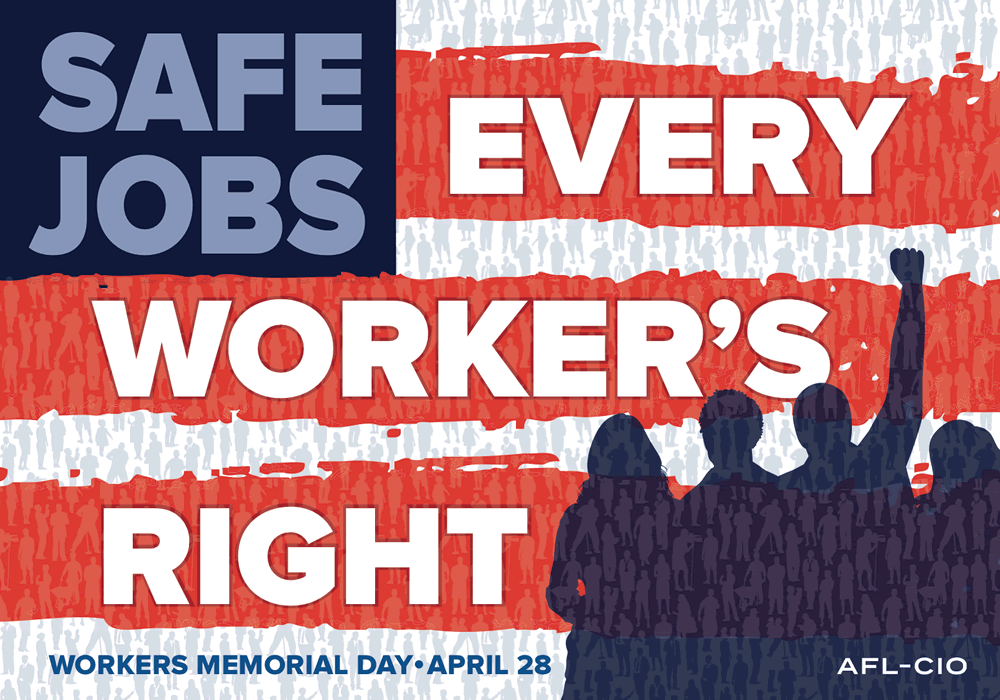

Share
The Republican Trump administration and the GOP-run Congress could undo years of progress in protecting safety and health on the job, the AFL-CIO’s top official in the field says. The progress has been great, but workers still die on the job every other hour, year-round.
In a telephone press conference accompanying the federation’s release of its annual Death on the Job report, AFL-CIO Safety and Health Director Peg Seminario said the impact would come from both repeal of regulations and from cuts in the Labor Department budget.
The federation released the report in connection with Workers Memorial Day, April 28, the day every year that unions call attention to health and safety in the workplace. Unions held commemorations and other activities in many states, including Minnesota.
DOL budget cuts could include cutting Occupational Safety and Health Administration (OSHA) and Mine Safety and Health Administration funds. Business wants to cut OSHA, particularly enforcement. Trump wants to cut the overall DOL budget 21 percent.
“What we’ve seen is a number of executive orders that deal with regulation,” or, to be more precise, deregulation, Seminario explained. “He (Trump) said during the campaign that he wants to cut rules by 70 percent, and this is one promise that it looks like he’ll keep.”
That could have a profound impact on future job safety and health of the nation’s workers, she said, especially since in the last eight years, the Democratic Obama administration implemented major rules to cut worker exposure to health hazards such as beryllium and silica. The fed’s report details the advances under Obama, too.
“And we did see penalties go up, particularly for serious violations” of job safety, Seminario said. OSHA and other federal agencies pushed that initiative through last year’s GOP-run Congress, convincing solons to raise OSHA fines for the first time since 1990 and then index them to inflation.
In an instance of the future harms Seminario fears from Trump and the GOP, the two repealed an OSHA rule requiring employers to retain accurate job safety and health records for five years, not six months. “We’ve also seen the delays in silica and beryllium rule enforcement and that can cost workers’ lives” even if those OSHA rules ultimately take effect, she warned.
OSHA started work on a new rule, pushed by National Nurses United, to force firms, especially health care institutions, to develop programs, warning and training to prevent workplace violence, notably on-the-job injuries to nurses and other female workers from violent patients and clients. But it did so only 10 days before Trump took office.
The budget cuts could also mean OSHA’s “capacity, or lack of capacity, to deal with” job safety and health violations on an industry-wide basis would shrink, Seminario warned. The agency already has so few inspectors, the report says, that a federal OSHA inspector can visit a covered workplace on an average of once every 159 years, a record low. An inspector from a state OSHA program the feds approved visits workplaces an average of once every 99 years. Those OSHAs could suffer from the budget cuts too: The feds supply half their funds.
Other key findings from the report, which covers deaths and injuries on the job in 2015, the most recent full year available, include:
- Hazardous working conditions killed 13 workers a day, 365 days a year. That works out to one death every other hour.
- A total of 4,836 workers were killed on the job in the United States in 2015, and the fatality rate “flatlined,” Seminario said, at 3.4 deaths per 100,000 workers, identical to 2014. That figure does not count the 50,000-60,000 workers who died last year from diseases they earlier contracted on the job, such as black lung disease and various cancers.
- Nearly 3.7 million work-related injuries and illnesses were reported, but the true toll, from workers comp claims and other data, is double to triple that number, the AFL-CIO says.
- The states with the highest death rates on the job were North Dakota (12.5 deaths per 100,000 workers), Wyoming (12 per 100,000), Montana (7.5 per 100,000), Mississippi (6.8 per 100,000), Arkansas (5.8 per 100,000) and Louisiana (5.8 per 100,000 workers). The first three, plus Louisiana, are high oil and gas production states. Oil and gas is a high-risk occupation, with a death rate of 11.4 per 100,000 workers in 2015.
- The number of Latino worker deaths on the job jumped by 99, to 903, in 2015. Their fatality rate was 4.0 per 100,000 workers, 18 percent above the national figure. Seminario said one reason is Latino workers are overrepresented in three high-hazard, high-death rate occupations: Farming, construction and transportation.
- A total of 937 construction workers were killed in 2015, the highest number in any sector.
- Workplace violence accounted for 26,420 lost-time injuries in 2015, and two-thirds of the injured workers are women. The largest number were in health care. Violence killed 703 workers in 2015, down from 765 the year before.

